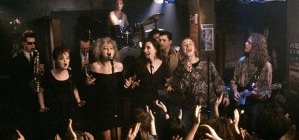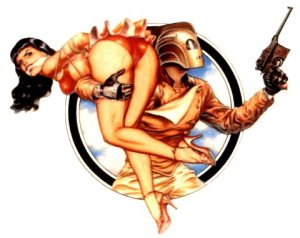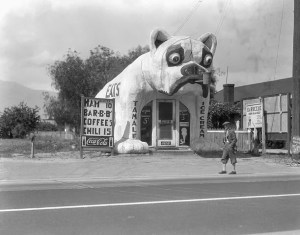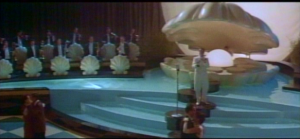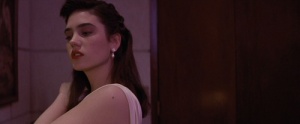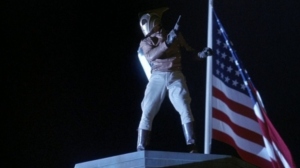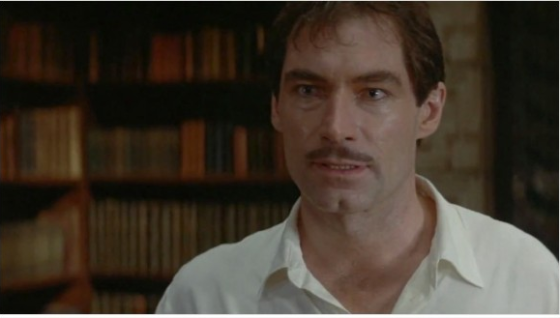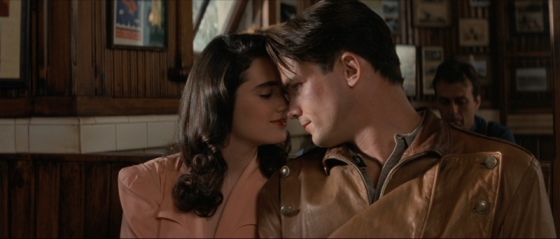In 1977, Star Wars was the big film in the science fiction genre. It dominated the Summer season and took off as a cultural artifact that continues to resonate today. The likelihood that another science fiction film would come on the scene and impress in the same ways seemed remote, but Steven Spielberg was just at the start of his career and the third major motion picture he directed was going to wow us in ways that were very similar to his pal George Lucas' little space opera. "Close Encounters of the Third Kind" is grounded in the everyday reality of audiences at that time. It was not set on a distant planet with space battles, it was taking place in our backyards, in Mexico, India and at a National Monument in Wyoming. The special effects were very different from "Star Wars" but equally compelling. When the Mothership shows up for the climax of the film, it almost makes you forget the space battles around the Death Star.
The film opened in December so it was a Holiday release and it did gangbusters business. It made more than a $100 million with maybe 300 screens during it's opening run. In 1977/78, that was real money. Three years later in a re-release in a "Special Edition" it added another $16 million. This week's run will add a smaller amount to the total but I think it is impressive that a 40 year old film still draws in enough customers to make a mark on the contemporary charts. The reason is simple, it was a great film in 1977 and it is still a great film, 40 years later.
Steven Spielberg is the consummate film director of the last fifty years. He may be rivaled creatively by directors such as Martin Scorsese or the Coen Brothers, but his track record of film success plus creativity is unparalleled. "Close Encounters" is entirely his baby. Although he has contributed to a few other film scripts that he directed, this is a solo credit, his only one. The inventiveness of the story and the odd way that it plays out building suspense as to what is happening to our sad hero is a testament to Spielberg's creativity with story. Of course his directorial choices are outstanding as well. From the start of the movie, when a black screen is accompanied by an otherworldly note, held for a moment but increasing in volume until a crash and then the screen fills with a desert sandstorm image, we are hooked. The mundane but complicated work of air traffic controllers, talking on a radio with the flight crews of airlines, depicted on a black and green screen as a set of numbers, comes across like a tense mystery with just enough humor to make it memorable. Finally in the opening sequence we meet the Neary family, who are like all of us. Their home is average, cluttered, and filled with loud kids and distracted parents. The floor of the boys bedroom may be one of the most accurate pieces of set design ever. At the heart of this story is Roy Neary, played by Richard Dreyfess, his second time in a row playing the Spielberg persona on screen in a Spielberg movie.
What happens to Roy on this night changes everything. His relationship with his wife and kids will be damaged in ways that look beyond repair, but it happens slowly. If Quint was obsessive about the Great White, well he had nothing on Roy Neary and the vague form that he keeps seeing in his food, bed and bathroom. At the start of the film he is a well meaning father who kiddingly threatens one son while trying to help the other one figure out fractions in an interesting way. He wants his kids to share the magic of his own childhood experiences and the recurring theme of Pinocchio is introduced. It is only a few days later that he indifferently trashes the house where they all live in a quest to figure out the symbol in his head. His oldest son is embarrassed and lashes out when Roy can't control his frustration and desperation. His wife, the wonderful Terri Garr, is mildly supportive but is also trying to protect him from himself. As much as there is to celebrate at the end of the film, there is plenty of tragedy to get us there. Roy's actual encounter is brilliantly shown with practical effects in the truck he drives for work and the fantastic conceptualization of the UFOs he chases that first night. Spielberg then allows him to undercut his own experience with a clever second encounter that is not at all what it seems. This is another writers touch that is well realized by the most sympathetic of directors.
There are a few moments that will leave modern audiences a bit bewildered. Roy trying to navigate using folded maps and not GPS is a pretty good example. At a official inquiry, a newsman points out that the absence of photos of UFOs is not proof of their non-existence any more than the absence of pictures of planes or cars crashing denies that those things happen [these days, that kind of film fills the evening news]. There is a great humorous sequence when the investigation team needs to read some map coordinates and instead of going on-line, they have to roll a giant globe from a government office to their workspace. So the technology might be dated but the story hold up well. Can we trust the government to tell us the truth? Do we know all there is to know about space? Are some crazy people maybe not crazy? Roy gets lumped in with a guy who believes in Bigfoot and that's enough to discredit him in a lot of eyes. He does discover an ally in Jillian, who has lost her son Barry to the visitors. Barry's disappearance is one of the sequences in the film that is iconic and it was really frightening. It was a moment that made you think this film could go anywhere and any point.
Melinda Dillon was nominated for an Oscar for her role as the distraught mother who also had the same kinds of obsessions as Roy. When the two of them finally work together as they arrive in Wyoming, you can feel the us versus them bonding between the two characters. Director François Truffaut was cast as the main scientific leader of the UFO team, and he works mostly because of his language barrier. Bob Balaban as the cartographer drafted as Truffaut's interpreter also acts as a surrogate for the audience on the inside of the plot. This dual approach to the story might give away too much but because Jillian and Roy don't connect till late in the film, and Balaban is sometimes unclear on what is happening, the suspense is maintained.
The climax of the movie is correctly remembered for the technical proficiency of the special effects and design teams and the outstanding score by John Williams. Williams has a huge number of Oscar nominations but probably fewer wins than he deserves because he was frequently matched against himself. This was one of those years. While most of the time he probably cancelled his competing nominations out, the classical score for Star Wars was not likely to ever be forgotten. His work in this film however is equally sublime and used in such a creative way in the story that maybe he should have received a co-screenwriting credit with Spielberg. Vilmos Zsigmond won the Academy Award for the cinematography of the film, but there were several other photographic geniuses that made contributions as well including: John Alonzo (Chinatown), William Fraker (Wargames),
László Kovács (Paper Moon), Douglas Slocombe (Raiders of the Lost Ark), Allen Daviau (E.T.), and a half dozen others.
There are many themes that you can pull out of this film and all of them feel like that could be the central focus. In the first part, mystery is at hand, in the second act it is obsession and the third transfers to both paranoia and hope. I always see this as a film that is ultimately about how the world can potentially be brought together by an event of this magnitude, or conversely how it could tear us apart. That dichotomy is the script again by the director himself. There are a hundred little moments that deserve more attention, and I hope that despite the fact that this is the first time I have written about this film, it won't be the last and those moments will have some light shined on them as well.
Addendum:
My friend Eric on the East Coast took his son to see this for the first time, while I was taking my daughter to see it today. Eric is a fine writer and he put together a nice post with a heartfelt message to Mr. Spielberg at the end. You might want to look at it here.









